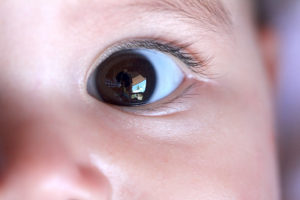
A baby’s eyes, large and luminous, capture our imaginations and our hearts.
Like magnets, they draw us in.
What do they see?
What do they think of this flurry of images parading past?
And what is going on with those precious peepers?
Plenty, said Brooke Geddie, DO, a pediatric ophthalmologist at Spectrum Health Helen DeVos Children’s Hospital.
From Day 1, newborn eyes are doing monumental work—as babies grow, develop and hone their vision.
“It’s really amazing when you look at the neuro-visual development that must occur for a child and ultimately an adult to see clearly,” Dr. Geddie said. “So much has to happen in that first year of life to give us the vision we are so reliant on in our everyday lives.”
Here is a look at the steps of a baby’s visual development, as well as tips for stimulating baby’s vision and advice on when to consult a specialist.
A black-and-white world
A full-term newborn baby sees “very minimally,” Dr. Geddie said. “When they are newborns, we only expect them to blink to a bright light.
“Initially at birth, a baby sees in black and white, and objects need to be within 8 to 12 inches.”
Researchers created images of what babies can see at various distances and tested adults’ ability to recognize faces and interpret facial expressions. This video captures some of those images.
The adults were most accurate at about 12 inches.
“That is about the distance at which a mother holds a baby when breastfeeding or bottle feeding,” Dr. Geddie said.
The structures of the baby’s eye are rapidly developing through infancy. That includes cells in the retina that allow us to see colors.
Neurological development also is underway.
A baby’s brain is developing the ability to process visual information and form a three-dimensional view of the world, which allows a baby to see depth.
“It takes both the eyes and the brain to see,” Dr. Geddie said.
And just like baby, the eyes are growing bigger.
“As the eyes grow, the power or prescription of the eye changes,” she said. “With each progressive month, with this brain and ocular development, their vision clarity improves, and the distance the baby is able to see is farther.”
This will enable an infant to focus on objects at a greater distance.
“The first year of life is the most important for visual development,” she said. “However, there is still neural-visual development that occurs up until around age 10 to 12.”
Through the first year
In the first two months, babies develop more clarity to their vision, and their color vision starts to develop.
“At this age group, we encourage parents to give their baby eye contact, to hold their baby close to their face, within that 1-foot distance,” Dr. Geddie said.
They begin to focus more clearly on faces, but their eyes still may not be coordinated. The eyes may wander or cross.
“We frequently get calls with questions or concerns about misaligned eyes in 1- or 2-month-old infants. But it is OK. This is expected at this stage of development,” Dr. Geddie said.
By the third or fourth month, a baby typically can focus with both eyes on an object. Their eyes should be straight now and will follow a toy, mom or a sibling, as they move.
By 5 to 8 months, babies have better control of their eye movement. They can see more clearly, and parents will notice eye-hand coordination developing.
“Babies start to reach for objects more. They are more able to judge distance and depth perception,” Dr. Geddie said.
“And their color vision is certainly more defined at that time.”
Helping baby see
Parents and caregivers can help stimulate an infant’s visual development.
Hold them close, talk to them and make eye contact—that helps overall development as well as visual development.
Expose them to books and images with high-contrast colors, shapes and patterns.
“They are going to be easier for them to see and most stimulating for their visual development,” Dr. Geddie said.
Vision screenings
To be alert for any problems with a baby’s vision, Dr. Geddie advised parents to stick with their regular well-child visits—which include vision screenings.
The American Association for Pediatric Ophthalmology and Strabismus lists the screening tests performed at well-child visits and the reasons a physician may refer a child to specialist.
Most babies will not need to see a pediatric ophthalmologist. But parents who are concerned about their child’s vision development also can request an evaluation by an ophthalmologist.
“If there’s a family history of eye disease with onset in early childhood or a strong family history for a need for glasses from a very young age, that might prompt a family to seek a formal eye examination, rather than relying just on screening,” she said.
Some syndromes or disorders that have a risk of ocular or visual concerns may also prompt this referral from your pediatrician or family doctor.
 /a>
/a>
 /a>
/a>
 /a>
/a>